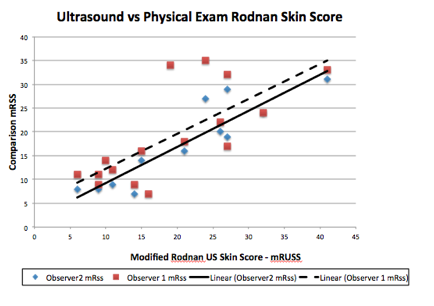Session Information
Title: Systemic Sclerosis, Fibrosing Syndromes, and Raynaud’s - Clinical Aspects and Therapeutics II
Session Type: Abstract Submissions (ACR)
Background/Purpose: Systemic sclerosis (SSc) is a multi-organ disease characterized by thickening, hardening and tightening of the skin. Skin thickening is described by physical exam and measured semi-quantitatively as the modified Rodnan skin score (mRSS). Ultrasound (US) has been investigated to measure skin thickening, however, approaches to convert and relate US findings to mRSS’s have not been adopted, in part because of the variability of normal skin thickness at different sites (as well as by age and gender). We present preliminary data reproducing a 17-point mRSS in scleroderma patients and controls by using mid frequency ultrasound (15mHz) and correlating it to physical exam findings. We propose development of an ultrasound adaptation of the mRSS: the Modified Rodnan Ultrasound Skin Score (mRUSS), which is easy to use, quantifiable, and allows ultrasound-based categorization of the skin in scleroderma patients.
Methods: We examined the skin of 16 patients (8 women) with diffuse cutaneous SSc and 10 healthy controls using a Sonosite M-Turbo 15mHz ultrasound machine operated by a single examiner. Each patient underwent a 17-point mRSS physical exam, and 12 patients had a second mRSS performed by an experienced rheumatologist. All patients then underwent a 17-point, comprehensive ultrasound skin exam at reproducible, predefined sites corresponding to the anatomic sites examined in the mRSS. The sites were: single sites on the face, chest wall, and abdomen, and bilateral 3rd finger, dorsum of the hand, extensor forearm, upper arm, thighs, lower legs, and the dorsal surface of the feet. Two dermal thickness measurements were taken from each image and averaged. The mean and standard deviation (SD) was calculated for controls at each site, and the z-score for each site calculated as [(skin thickness)-(mean control thickness at that site)]/(SD of control at that site)].
Results: Various cut-points were tested for translating the z-score to mRUSS’s assigned to each anatomic site, and the best concordance between the overall mRSS and the overall mRUSS were obtained with the following criteria: z-score <1= mRUSS 0; z-score 1-3=mRUSS 1; z-score 3-5 =mRUSS 2; z-score >5 =mRUSS 3. Total mRUSS’s were then correlated to the mRSS (physical exam). The correlation between observer 1 mRSS compared to US score (assuming this to be the gold standard) was .90 and .73 for observer 2 (less experienced provider) (see figure 1). The r-value comparing observer 1 to observer 2 was 0.97.
Conclusion: Use of mid frequency US (15-mhz) is a readily available, reproducible, objective method for evaluating skin thickness in scleroderma. The newly proposed mRUSS scoring system correlates well with the mRSS based on physical exam findings. These findings will require verification with more patients and by independent examiners, but they have promise for use of precise ultrasound measurements to generate a mRSS equivalent.
Disclosure:
I. Sacksen,
None;
P. S. Pollock,
None;
M. H. Wener,
None.
« Back to 2013 ACR/ARHP Annual Meeting
ACR Meeting Abstracts - https://acrabstracts.org/abstract/modified-rodnan-ultrasound-skin-score-an-ultrasound-skin-scoring-approach-in-systemic-sclerosis/

